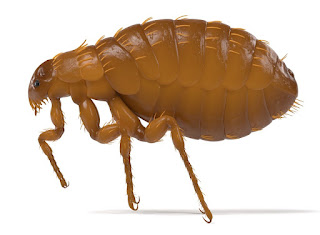Fleas are wingless insects, 1.5 to 3.3 millimetres (1⁄16 to 1⁄8 inch) long, that are agile, usually dark colored (for example, the reddish-brown of the cat flea), with a proboscis, or stylet, adapted to feeding by piercing the skin and sucking their host's blood through their epipharynx. Flea legs end in strong claws that are adapted to grasp a host.
Unlike other insects, fleas do not possess compound eyes but instead only have simple eyespots with a single biconvex lens; some species lack eyes altogether. Their bodies are laterally compressed, permitting easy movement through the hairs or feathers on the host's body. The flea body is covered with hard plates called sclerites. These sclerites are covered with many hairs and short spines directed backward, which also assist its movements on the host. The tough body is able to withstand great pressure, likely an adaptation to survive attempts to eliminate them by scratching.
Fleas lay tiny, white, oval eggs. The larvae are small and pale, have bristles covering their worm-like bodies, lack eyes, and have mouth parts adapted to chewing. The larvae feed on organic matter, especially the feces of mature fleas, which contain dried blood. Adults feed only on fresh blood.
Jumping
Their legs are long, the hind pair well adapted for jumping; a flea can jump vertically up to 18 cm (7 in) and horizontally up to 33 cm (13 in), making the flea one of the best jumpers of all known animals (relative to body size), second only to the froghopper. A flea can jump more than 100 times its length (vertically up to 7 inches and horizontally 13 inches). That's equivalent to an adult human jumping 250 feet vertically and 450 feet horizontally. Rarely do fleas jump from dog to dog. Most flea infestations come from newly developed fleas from the pet's environment. The flea jump is so rapid and forceful that it exceeds the capabilities of muscle, and instead of relying on direct muscle power, fleas store muscle energy in a pad of the elastic protein named resilin before releasing it rapidly (like a human using a bow and arrow). Immediately before the jump, muscles contract and deform the resilin pad, slowly storing energy which can then be released extremely rapidly to power leg extension for propulsion. To prevent premature release of energy or motions of the leg, the flea employs a "catch mechanism". Early in the jump, the tendon of the primary jumping muscle passes slightly behind the coxa-trochanter joint, generating a torque which holds the joint closed with the leg close to the body. To trigger jumping, another muscle pulls the tendon forward until it passes the joint axis, generating the opposite torque to extend the leg and power the jump by release of stored energy. The actual take off has been shown by high-speed video to be from the tibiae and tarsi rather than from the trochantera (knees).
Read more, here.
Jeff Verges/Owner/Operator
742 Santa Anita Court
Eugene, OR 97401
541-688-0580 Eugene
503-371-8373 Salem


No comments:
Post a Comment